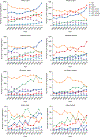NASH Leading Cause of Liver Transplant in Women: Updated Analysis of Indications For Liver Transplant and Ethnic and Gender Variances
- PMID: 29880964
- PMCID: PMC9083888
- DOI: 10.1038/s41395-018-0088-6
NASH Leading Cause of Liver Transplant in Women: Updated Analysis of Indications For Liver Transplant and Ethnic and Gender Variances
Abstract
Objectives: Chronic infection with hepatitis C virus (HCV) was previously the leading indication for liver transplant (LT) in the United States. However, since 2014 the use of direct-acting antivirals (DAAs) has decreased the chronic HCV burden, while the prevalence of nonalcoholic steatohepatitis (NASH) has risen substantially through the last decade. Both gender and ethnic disparities in indications for LT have been shown in the past but no data on this have been reported since the implementation of DAAs.
Methods: We assessed changes in etiologies for LT listing and in gender and ethnic differences in those listed for LT. Adult patients registered for LT in the United Network for Organ Sharing/Organ Procurement and Transplantation Network database between January 1, 2004 and December 31, 2016 were included. Multinomial logistic regression modeling was used to test for changes in waitlist or liver transplant rates.
Results: The study included 127,164 adult patients registered for LT. By 2016, alcoholic liver disease (ALD) was the leading etiology for waitlisting and LT; NASH was second; hepatocellular carcinoma (HCC) due to chronic HCV and chronic HCV alone were 3rd and 4th. NASH was the leading cause for LT for women and the 2nd leading cause for men (following ALD). NASH increased as the cause in all ethnic subgroups and was the leading cause in 2016 among Asian, Hispanic, and non-Hispanic white females. We also found that although the indication for liver transplant for hepatocellular carcinoma (HCC) due to HCV has increased over the years, this indication decreased for the first time between 2015 and 2016 in both males and females.
Conclusions: NASH is currently the second leading cause for LT waitlist registration/liver transplantation overall, and in females, the leading cause. Given the rate of increase, NASH will likely rise to become the leading indication for LT in males as well.
Figures




Comment in
-
Non-Alcoholic Steatohepatitis as a Growing Indication for Liver Transplantation: The Evolving Gender and Ethnic Trends.Am J Gastroenterol. 2018 Nov;113(11):1588-1589. doi: 10.1038/s41395-018-0373-4. Epub 2018 Oct 23. Am J Gastroenterol. 2018. PMID: 30353054
References
-
- Kim WR, Lake JR, Smith JM, et al. OPTN/SRTR 2015 annual data report: liver. Am J Transplant. 2017;17(Suppl 1):174–251. - PubMed
-
- Wong RJ, Aguilar M, Cheung R, et al. Nonalcoholic steatohepatitis is the second leading etiology of liver disease among adults awaiting liver transplantation in the United States. Gastroenterology. 2015;148:547–55. - PubMed
MeSH terms
Substances
Grants and funding
LinkOut - more resources
Full Text Sources
Other Literature Sources
Medical
Miscellaneous

